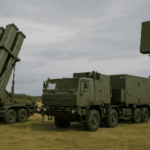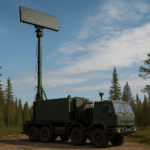The Dutch government has ordered nine more Lockheed Martin F-35A Lightning II fighters, lifting the Royal Netherlands Air Force (RNLAF) plan from 37 to 46 aircraft. State Secretary Barbara Visser told Parliament the purchase slots into the Joint Program Office (JPO) production queue and keeps deliveries on track for 2022-2024.
Air-force planners argue the extra jets solve a simple math problem. The Netherlands must police national airspace around the clock, send four fighters on sustained NATO duty, and still train crews. Forty-six aircraft give two full squadrons enough airframes to cover each task without running maintenance or pilot schedules to the breaking point. The order also lays the groundwork for a third squadron once personnel, spares, and simulators catch up.
Netherlands F-35 Expansion Boosts Combat Readiness and NATO Commitment
Visser’s letter stresses that the new batch follows the same “turn-key” model as the first 37. Every aircraft arrives with its share of support gear so the fleet grows as a single system rather than a patchwork. The package includes:
- spare Pratt & Whitney F135 engines and line-replaceable modules
- full-mission and desktop simulators for Leeuwarden and Volkel
- Autonomic Logistics Information System (ALIS) servers, soon to migrate to the ODIN backbone
- calibrated torque tools, composite-specific fixtures, and stealth-skin repair kits
- on-board electronic-warfare sets and classified mission-data files
Adding airframes means adding concrete. Leeuwarden already fields operational F-35s but still needs hardened shelters, chilled power supplies, and low-observable wash racks sized for the extra tails. Volkel will build blast-proof bays and a deployable flight-line tent set for expeditionary detachments. Defense Estates Service pegs infrastructure at roughly €85 million and expects hand-over before the first of the new lot lands home.
Finance officials priced the aircraft package at €1.016 billion and set aside a €143 million risk reserve for currency swings, block-upgrade inserts, or inflation. The sum fits inside the “National Plan” envelope written into the Spring Memorandum and aligns with recent increases in the overall cost of the F-35 program, which rose by $26 billion last year alone. The government’s cost model assumes the euro stays near the current dollar rate and that Lot 16 production hits schedule. If Technical Refresh 3 slips into Lot 17, the order could shift right by six to twelve months but would still meet the Air Force’s force-structure target date of 2024.
Fleet size drives operating cost. Budget planners forecast €43 million in 2023, €93 million in 2024, and €97 million a year from 2025 for the extra nine aircraft. The curve covers fuel, munitions, spares, software licenses, depot back-shop hours, and about 220 new uniformed and contract posts. Defense staff note that spreading fixed expenses – base security, tech manuals, data links – across more hulls lowers the average flight-hour bill compared with the aging F-16AM fleet.
Dutch F-16 Fleet Retirement Drives Need for Modern Replacements
Dutch industry stands to gain. As a Tier 2 partner, the Netherlands poured close to $800 million into early F-35 development and now supplies global production. GKN Fokker makes flaperon skins and arrestor-hook mountings; Aeroned fashions titanium hydraulic blocks; Thermo Fisher machines composite frames. Lockheed Martin’s latest supplier scorecard lists five Dutch companies in its top “Elite” tier for on-time, on-quality delivery, and sustainment contracts stretch decades.
Strategic context drives urgency. Russian Tu-95 and Su-30 flights skirt the Baltic and North Sea air picture almost weekly, putting Dutch fighters on scramble alert. NATO also asks every northern member to field at least eight fifth-generation jets for Baltic Air Policing, Iceland air defense, or the Very High Readiness Joint Task Force. Forty-six aircraft let the Netherlands meet that pledge while retiring F-16s that first flew in 1979. Only 61 Falcons remain in service, and maintenance officers label parts support “increasingly fragile.”
Parliament broadly supports the buy. Christian Democrats and Liberals cite alliance credibility and aerospace jobs; Labour voices concern over life-cycle cost but concedes the F-16 fleet can no longer shoulder NATO’s task list. The Party for Animals alone calls for a pause, arguing that climate funds should outrank jet orders. Visser replies that modern engines burn less fuel for more effect and that fighter pilots cannot police the sky with recycling schemes.
Training keeps pace. Student pilots now log fifty hours in high-fidelity simulators at home before crossing the Atlantic to Luke AFB, Arizona, for live flights. The Dutch syllabus meshes with U.S. and Danish courses, letting instructors trade cockpit seats and allowing small air forces to share tail numbers in the jet-hungry early phase. Once the nine extra aircraft arrive, the RNLAF will boost its instructor cadre by one-third and aim for ten new mission-ready pilots each year.
Capability jump matters. The F-35’s AN/APG-81 AESA radar, Electro-Optical Distributed Aperture System, and sensor-fusion core give Dutch crews a clear picture even over the Baltic’s cluttered sea clutter. Stealth cuts detect-to-engage ranges, and internal fuel tanks triple loiter time compared with the F-16. The jet also carries the new B-61-12 free-fall nuclear bomb under NATO’s dual-capable aircraft program – an assigned task for the Netherlands since the Cold War.
Dutch F-35 Capabilities Outpace Legacy Netherlands F-16 Fleet
Procurement history shows a long road. The Hague first penciled 85 F-35s into its 2002 Defense White Paper, scaled that to 68 in 2011, and dropped to 37 in 2013 to stay within a €4.5 billion capital cap. Better economic growth and sharper security pressure revived expansion talk in 2018, leading to the current 46-jet plan. Defense economists say the nine-aircraft “delta” costs less than half the per-plane price paid in 2013 thanks to higher production volume and a stronger euro.
Acceptance milestones come fast. Three Dutch-built wings join final assembly at Fort Worth in April 2021. First flight for the lead jet is slated for December 2021, followed by U.S. government acceptance in February 2022 and ferry flight to Leeuwarden that spring. All nine should reach Dutch soil by late 2024, slotting straight into Squadron 322 while Squadron 312 at Volkel completes its own conversion from F-16s.
NATO partners welcome the news. Belgian officers eye Dutch progress as Belgium builds its own 34-jet fleet. Norway’s 332 Squadron shares software labs with the Dutch centre at Woensdrecht. Italian engineers test-fly Dutch jets at Cameri during final checks, and British No. 617 Squadron routinely trains with Dutch pilots on Link-16 and Multifunction Advanced Data Link nodes. Standard kits and joint tactics shrink planning time for combined packages over the High North or Black Sea.
Oversight remains tight. Under the Major Projects procedure, the Defense Ministry must file semi-annual progress notes to Parliament. The next brief, due in March 2020, will show the signed Letter of Offer and Acceptance, the production Lot assignment, and any updated cost baseline once contract currency rates lock. A Defense Audit Service team will track spending, and the Court of Audit holds the right to sample purchase orders down to torque wrenches.
Visser sums up the deal in one phrase: “More jets mean more safety, more jobs, and more weight inside NATO.” For Dutch crews used to coaxing forty-year-old Falcons through modern missions, the extra nine Lightnings promise margin – margin to train, to deploy, and to come home on schedule.
Dutch F-35 Program Reaches 40 Jets – March 2025 Update
The Royal Netherlands Air Force now fields 40 F-35As and passed 18,000 flight hours in February. The last Dutch F-16 flew to the Boneyard in October 2024, letting the Lightning fleet take every alert scramble, nuclear standby, and overseas rotation. Minister of Defense Ruben Brekelmans used that milestone to unveil a €2.4 billion add-on package that includes six further F-35s, ground refuellers, and a secure engine-maintenance bay at Volkel. Parliament approved the plan in September 2024, pushing the programme of record to 52 aircraft.
Lockheed Martin and the JPO signed the Letter of Offer on 12 February 2025. The six airframes join Lot 20, carry the Block 4 software core, and will reach Dutch soil in 2028-2029. Their arrival triggers the rebirth of 313 Squadron, mothballed since 2012, at Leeuwarden. Command will keep two aircraft on NATO nuclear duty, six available for quick-reaction alert, and eight free for training or deployment – flexibility not seen since the early F-16 era.
Dutch F-35s flew Baltic Air Policing out of Šiauliai, Lithuania, from September to December 2024. Crews intercepted Russian Su-30SM fighters three times, sharing track files with Spanish Eurofighters and Lithuanian control sites. In January 2025, two Dutch jets used the Keystone gateway to pass target coordinates to an Israeli-built PULS rocket battery during Exercise Allied Storm in Germany, marking the Netherlands’ first cross-domain live-fire with fifth-generation airborne sensors and ground launchers. That same month, Dutch and Norwegian F-35s were deployed to Poland to help secure NATO’s eastern flank.
Dutch F-35 Deployments Showcase Multinational Sensor and Strike Integration
Infrastructure keeps pace. Volkel broke ground on a NATO-funded hardened shelter complex and a secure engine test cell in November. The Defense Estates Service says both projects will finish by mid-2026. At Woensdrecht, GKN Fokker opened a wing-panel overhaul line for Dutch, Danish, and Belgian fleets, making the Netherlands the Benelux hub for heavy F-35 maintenance.
Industrial wins extend beyond airframes. Dutch suppliers now cut cockpit pressure vessels, machine lift-fan clutch actuators, and cast titanium main-gear lugs. Lockheed Martin’s 2024 supplier-performance list again places five Dutch firms in its top tier for on-time delivery.
Aircrews push tactics. During a February media day, pilots showed how passive AESA modes let them guide RAF Typhoons onto targets without lighting their own radars. Air Commodore Stephan de Kraaf called the sensor fusion “a force multiplier that lets a small nation punch above weight while staying inside NATO playbooks.”
Looking forward, the Defense White Paper due in June will weigh a fourth squadron once spare-parts flow improves and sustainment costs stabilise. Brekelmans hints the option stays alive if security pressures keep rising. Any move would depend on the 2026 budget cycle and progress on multinational spare-engine pooling.For now, the nine aircraft ordered in 2019 fly front-line missions, the six authorised in 2024 are on order, and every Dutch F-16 sits in a museum, target range, or outbound shipment to Ukraine. Separately, retired RAAF Hornets could soon bolster Ukraine’s air force as Australia weighs their transfer following U.S. approval. The stealth era is no longer Dutch ambition; it is Dutch routine.
REFERENCE SOURCES
- https://www.twz.com/air/dutch-f-35s-provide-targeting-for-rocket-artillery
- https://dsm.forecastinternational.com/2019/10/09/netherlands-set-to-purchase-nine-more-f-35s/
- https://militaryleak.com/2019/10/10/royal-netherlands-air-force-to-order-nine-more-f-35s-for-e1-bn/
- https://aviationweek.com/defense/aircraft-propulsion/netherlands-buy-six-more-f-35s
- https://www.defensenews.com/global/europe/2024/09/09/netherlands-to-add-tanks-f-35s-frigates-amid-warnings-of-war/
- https://www.defensenews.com/global/europe/2025/03/11/f-35-partners-fully-committed-to-program-dutch-defense-minister-says/
- https://www.janes.com/osint-insights/defence-news/defence/netherlands-declares-foc-for-f-35-retires-f-16
- https://www.flightglobal.com/defence/last-dutch-f-16s-retire-after-types-45-years-of-service/160119.article
- https://www.f35.com/f35/global-enterprise/netherlands.html
- https://english.defensie.nl/topics/f-35-to-the-netherlands
- https://news.lockheedmartin.com/2025-04-14-Royal-Netherlands-Air-Force-and-Lockheed-Martin-Skunk-Works-R-Achieve-Breakthrough-F-35-Interoperability-at-Ramstein-Flag



